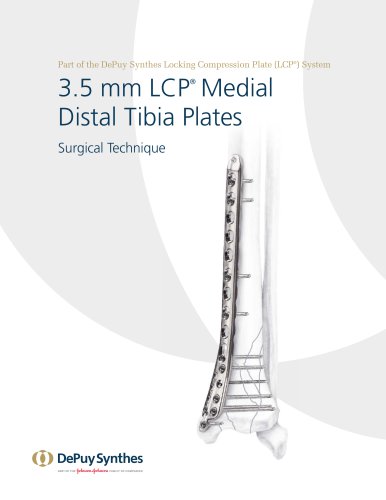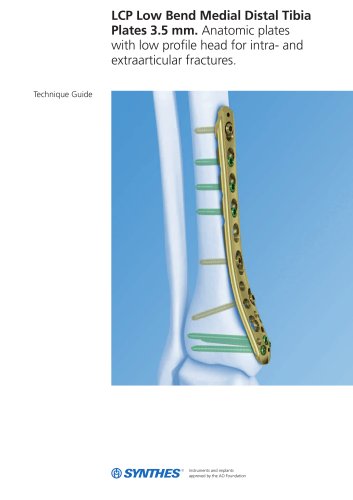 Website:
Depuy Synthes
Website:
Depuy Synthes
Group: Johnson & Johnson
Catalog excerpts

Surgical Technique This publication is not intended for distribution in the USA. Instruments and implants approved by the AO Foundation. DePuy Synthes companies of
Open the catalog to page 1
Image intensifier control This description alone does not provide sufficient background for direct use of DePuy Synthes products. Instruction by a surgeon experienced in handling these products is highly recommended. Processing, Reprocessing, Care and Maintenance For general guidelines, function control and dismantling of multi-part instruments, as well as processing guidelines for implants, please contact your local sales representative or refer to: http://emea.depuysynthes.com/hcp/reprocessing-care-maintenance For general information about reprocessing, care and maintenance of Synthes...
Open the catalog to page 2
Introduction LCP Percutaneous Aiming System 3.5 for PHILOS 2 Surgical Technique Patient Positioning and Approach 5 Product Information Implants 23 LCP Percutaneous Aiming System 3.5 for PHILOS Surgical Technique DePuy Synthes
Open the catalog to page 3
LCP Percutaneous Aiming System 3.5 for PHILOS. For less invasive surgery at the proximal humerus. The Sleeve System – Screw holes are accessible by sleeve system for percutaneous screw insertion – Outer sleeves snap into the aiming arm for quick assembly and removal – Different drill sleeves for the option of locking and cortex screw insertion – Color-coding facilitates system orientation ᕤ Insertion handle can be used independently from aiming arm Radiolucent aiming arm to enable control view under image intensifier Screw holes are percutaneously accessible by the sleeve system ᕥ Blocked...
Open the catalog to page 4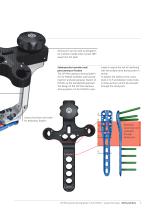
Aiming arm can be used as elongation for insertion handle when turned 180° away from the plate Submuscular insertion and percutaneous fixation The LCP Percutaneous Aiming System 3.5 for PHILOS facilitates submuscular insertion and percutaneous fixation of PHILOS via the transdeltoid approach. The design of the LCP Percutaneous Aiming System 3.5 for PHILOS is opti- mized to reduce the risk of interfering with the axillary nerve during screw insertion. To protect the axillary nerve, screw levels C to F are blocked. Screw holes in these sections cannot be accessed through the aiming arm. A...
Open the catalog to page 5
In 1958, the AO formulated four basic principles, which have In 1958, the guidelines for internalbasic principles, which AO formulated four fixation1,2. become have become the guidelines for internal xation1, 2. Anatomic reduction Anatomic Fracture reduction and xation Fracture reduction and fixation to to restore anatomical relationships. restore anatomical relationships. 1 Early, Early, active mobilization mobilization Early and Early and safe mobilization and mobilization and rehabilitation of the injured part and rehabilitation the injured part the the patient as a whole. and patient as...
Open the catalog to page 6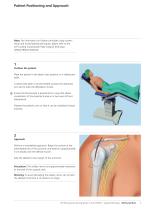
Patient Positioning and Approach Note: For information on fixation principles using conventional and locked plating techniques, please refer to the LCP Locking Compression Plate Surgical Technique (DSEM/TRM/0115/0278). 1 Position the patient Place the patient in the beach chair position on a radiolucent table. A lateral side table is recommended to place the abducted arm and to relax the deltoideus muscle. Ensure the fluoroscope is positioned in a way that allows v isualization of the proximal humerus in two axes (AP and lateral/axial). Prepare the patient’s arm so that it can be mobilized...
Open the catalog to page 7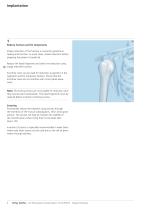
1 Reduce fracture and fix temporarily Proper reduction of the fracture is crucial for good bone h ealing and function. In some cases, closed reduction before prepping the patient is beneficial. Reduce the head fragments and check the reduction using image intensifier control. Kirschner wires can be used for reduction as joysticks in the fragments and for temporary fixation. Ensure that the Kirschner wires do not interfere with correct plate placement. Note: The locking screws are not suitable for reduction since they cannot exert compression. The head fragments must be reduced before...
Open the catalog to page 8
2 Prepare plate position Note: The LCP Percutaneous Aiming System 3.5 for PHILOS is used with the PHILOS plate. Please consult the surgical technique “Philos and Philos long” (DSEM/TRM/0815/0449) for detailed information on the implant and its indications. For optimal plate positioning, insert two positioning Kirschner wires 2–4 mm lateral to the bicipital groove and 5–7 mm below the tip of the greater tubercule. Precaution: Placing the plate too high increases the risk of subacromial impingement. Placing the plate too low can prevent the optimal distribution of screws in the humeral head....
Open the catalog to page 9
3 Assemble the PHILOS aiming system Instruments 314.550 Screwdriver Shaft, hexagonal, small, B 2.5 mm, length 165 mm, for Quick Coupling or 03.113.019 Screwdriver Shaft 3.5 Stardrive, T15, long, self-holding, for AO/ASIF Quick Coupling 03.122.006 or 03.122.035 Insertion Handle for PHILOS – Proximal Humeral Plate 3.5, with Connecting Screw, hexagonal socket Handle with Quick Coupling Aiming Arm for PHILOS – Proximal Humeral Plate 3.5 Insertion Handle for PHILOS – Proximal Humeral Plate 3.5, with Connecting Screw, Stardrive T15 Attach the insertion handle to the plate by aligning the...
Open the catalog to page 10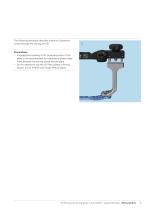
The following technique describes insertion of proximal screws through the aiming arm (3). Precautions: –– Intraoperative bending of the proximal portion of the plate is not recommended for maintaining proper alignment between the aiming device and the plate. –– Do not attempt to use the LCP Percutaneous Aiming S ystem 3.5 for PHILOS with longer PHILOS plates. LCP Percutaneous Aiming System 3.5 for PHILOS Surgical Technique DePuy Sy
Open the catalog to page 11
4 Insert plate Slide the plate into the subdeltoid space and along the bone. Always keep the plate in contact with bone. Warning: Do not injure the axillary nerve. The axillary nerve can be palpated at the lower margin of the incision. Precaution: Do not use the insertion handle and the plate for soft tissue retraction or for release or dissection of the deltoid insertion. 11 DePuy Synthes LCP Percutaneous Aiming System 3.5 for PHILOS Surgical Tech
Open the catalog to page 12All Depuy Synthes catalogs and technical brochures
-
ZERO-P NATURAL™PLATE
5 Pages
-
2.0 mm LCP® Distal Ulna Plate
20 Pages
-
SYNFLATE SYSTEM
3 Pages
-
2.4 mm VA LCP™
4 Pages
-
Building on Success
16 Pages
-
HEALIX ADVANCE
4 Pages
-
RADIUS OF CURVATURE
3 Pages
-
Introducing The Variable Angle
12 Pages
-
HEALIX Anchor™ 3.4 mm
2 Pages
-
Small Battery Drive II
4 Pages
-
HEALIX ADVANCE
4 Pages
-
3.5 mm LCP™ Medial
15 Pages
-
Titanium Sternal Fixation System
34 Pages
-
MatrixRIB®FixationSystem
86 Pages
-
Mandible Trauma Solutions
2 Pages
-
Power line II
4 Pages
-
Concorde
28 Pages
-
LCP Intercarpal
31 Pages
-
LCS® COMPLETE™
2 Pages
-
Synthes TPLO.
8 Pages
-
SynFix-LR System
56 Pages
-
ATB Anterior Tension Band Plate
32 Pages
-
CONDUIT™
15 Pages
-
Brochure_FINAL
2 Pages
-
DePuy Synthes
81 Pages
-
Anspach
3 Pages
-
Orthopedic Foot Instruments
32 Pages
-
PINNACLE® Hip Solutions
12 Pages
-
Corail
24 Pages
-
S-ROM® NOILES™
68 Pages
-
TRI-LOCK® Product Rationale
12 Pages
-
Reclaim Surgical Technique
44 Pages
-
Speed
2 Pages
-
attune
80 Pages
-
HAMMERLOCK® 2
2 Pages
-
DePuy Glenoid Solutions
2 Pages
-
Trauma Solutions. Elbow
4 Pages
-
Polar
4 Pages
-
Alveolar Distractor.
4 Pages
-
Piezoelectric System
4 Pages
-
Air Power Line II
6 Pages
-
LCP Clavicle Hook Plate
4 Pages
-
TruMatch Pin Guides
16 Pages
-
P F N A
8 Pages
-
SKILL, DEDICATION,
16 Pages
-
Orthopaedics. Overview
20 Pages
-
DURALOC
16 Pages
-
Marathon Cemented Cup
20 Pages
-
REEF Surgical Technique
16 Pages
-
MatrixNEURO
8 Pages
-
Anspach XMax
4 Pages
-
Anspach eMax 2 Plus
4 Pages
-
Small Electric Drive
4 Pages
-
Air Pen Drive
4 Pages
-
Colibri II
4 Pages
-
Spine
25 Pages
-
Expert Hindfoot Arthrodesis Nail
48 Pages
-
LCP Distal Fibula Plates
32 Pages
-
TomoFix
60 Pages
-
Expert Tibial Nail PROtect
16 Pages
-
Expert Tibia Nail
84 Pages
-
Sacral Bars
16 Pages
-
Pelvic C-Clamp
20 Pages
-
Low Profile Pelvic System
16 Pages
-
Proximal Femoral (Hook) Plate
24 Pages
-
LCP
24 Pages
-
PFNA
112 Pages
-
HCS 1.5, 2.4, 3.0
36 Pages
-
LCP Wrist Fusion
32 Pages
-
LCP Compact Hand
28 Pages
-
VA-LCP Elbow
48 Pages
-
Distal Radius
44 Pages
-
Olecranon
30 Pages
-
LCP Hook Plate
28 Pages
-
DHP & Olecranon
4 Pages
-
LCP S-A
4 Pages
-
Epoca
4 Pages
-
Philos
32 Pages
-
MultiLoc
68 Pages














